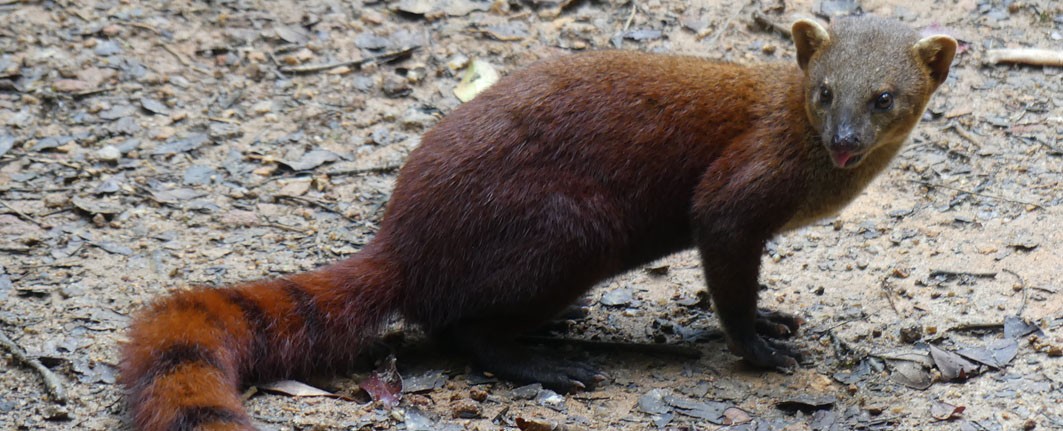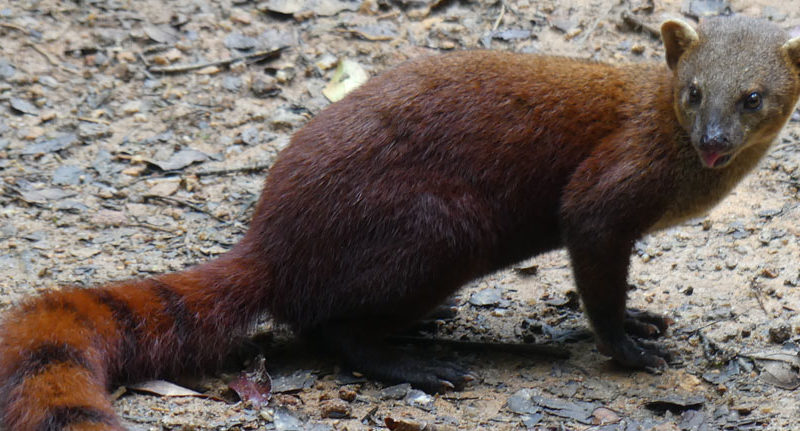
There are 11 species of Malagasy carnivorans, of which the four most likely to be seen by visitors are covered here. Sighting even one of these four species takes some luck, as these are scarce and retiring creatures.
Ring-tailed Vontsira (Galidia elegans)
DISTRIBUTION: Found in most of the island’s rainforest, and in Sambirano forest. Scarce in the western dry forest, and absent from the spiny forest.
ID: Dark reddish coloration and long, ringed tail easily identify it: formerly called Ring-tailed Mongoose.
VOICE: The most frequently heard call is a high-pitched whistle. Also gives a low-pitched, quiet chattering.
BEHAVIOUR: Generally diurnal, and found alone or in small groups, on the ground or in trees. Its diverse diet includes small mammals, birds, reptiles, amphibians, fish and invertebrates. Young are born between November and January.
WHERE TO SEE: Fairly tame individuals can be seen around the campsites in Ankarana and Amber Mountain NPs. Also seen regularly in eastern rainforest, especially Ranomafana NP, and in western dry forest in Tsingy de Bemaraha NP.
Northern Bokiboky (Mungotictis decemlineata)
DISTRIBUTION: A small area of western dry forest centred on Morondava.
ID: Mongoose-like shape, with long nose and bushy tail. Eight to ten fine lines on the back and sides: formerly called Narrow-striped Mongoose.
VOICE: Quiet “tok tok tok” calls, given by members of group to stay in touch.
BEHAVIOUR: Generally diurnal and social, found in groups of up to 12. Most often on the ground, but also climbs trees. Eats mainly insects, but also other invertebrates, small mammals, and reptiles. The single young is born between October and December.
WHERE TO SEE: Fairly common in Kirindy Forest, often in the camp itself.
Spotted Fanaloka (Fossa fossana)
DISTRIBUTION: Mainly in eastern rainforest, although also occurs in drier forest in the north.
ID: Heavily spotted and striped on the back. Quite similar to the introduced Small Indian Civet Viverricula indica (not illustrated), but the civet is larger, with thicker legs, a longer body, and a tail with complete rings.
VOICE: Not frequently heard, but does make a contact call described as “coq-coq”.
BEHAVIOUR: A shy, nocturnal species that is found singly or in pairs, usually on the ground or low in trees. Feeds on small mammals, reptiles, frogs and invertebrates. The single young is born during the wet season
WHERE TO SEE: Extremely shy. Formerly habituated at ‘Belle Vue’ along the main trails at Ranomafana NP, but the current night walk ban precludes seeing this species there. Occasionally spotted elsewhere in Ranomafana NP, in Ankarana NP, and in other parks, but seeing this animal requires luck.
HT AGENCY TOURS
Luxury Madagascar with the best luxury African safari tours packages. Discover your next perfect destination with HT Agency Tours

